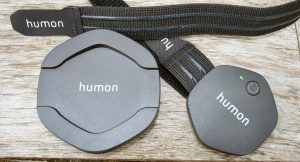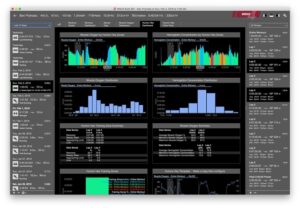 Since my Humon Hex Review from just over 3 months ago I’ve kept on using the Hex 2-3 times a week (out of over 10 sessions/week). I had hoped to have more epiphanies but that extra, post-review usage has mostly just firmed up my thoughts on what I knew I was going to do with it in any case.
Since my Humon Hex Review from just over 3 months ago I’ve kept on using the Hex 2-3 times a week (out of over 10 sessions/week). I had hoped to have more epiphanies but that extra, post-review usage has mostly just firmed up my thoughts on what I knew I was going to do with it in any case.
That’s the general thrust.
But I have found getting used to using Hex somewhat similar in principle to how I increasingly got into using STRYD. At the start I was using ‘just another gadget’ and trying to find the insights that I was supposed to find. But, just like with STRYD, as the weeks passed then so I caught on to one or two specific areas that I watched closely a few more times and then closer still the next few times. Then at some point, just as 365w of running power ‘means’ something to me, so now does 69% SmO2 also mean something to me near the start of a workout.
Perhaps I’ve gone from understanding SmO2 to internalising it in some way?
Warming Up
The biggest and easiest and most obvious win with Hex is warming up. I can now quantify what ‘feeling right’ means if I am about to push myself afterwards in a hard session. And I can say with some degree of certainty that sometimes my previous warmups were, politely, “sub-optimal” 😉
Broadly speaking I now know that I need three FTP-like efforts for about 30 seconds each interspersed with easy efforts and with a full SmO2 recovery. If I do ‘roughly that’ then my SmO2 always rises by 10-15 percentage points from the starting level. The exact percentage point increase varies on the muscle and the precise position of the sensor on the muscle.
The time for me to make a ‘full SmO2 recovery’ is probably also longer than I would previously taken. So Hex has been useful there.
I’ve found that doing what the Hex considers to be a complete warmup and then going straight into a race-like effort produces sub-optimal results. I either need to stop the warmup before SmO2 peaks or, probably more correctly, allow over 10 minutes between warmup and workout. There is a probably an element of ‘tell me something I didn’t already know’ there but I’ve, sort of, quantified it enough for my own satisfaction.
In my Humon Hex Review I looked at this consumer-level warmup from British Cycling and concluded for me that it certainly didn’t get my SmO2 levels up high enough
However another British Cycling warmup, this time one which Training Peaks apparently uses, DOES work correctly for me. However, as I said earlier, if I am entering the workout with slight fatigue from previous days then I find it best to wait a little after this warmup before doing the real stuff. Here is the BC warmup
- 5m @ 45% FTP (90 RPM)
- 2m @ 55% FTP (95 RPM)
- 2m @ 65% FTP (100 RPM)
- 2m @ 75% FTP (105 RPM)
- 90s @ 85% FTP (110 RPM)
- 30s @ 100% FTP (120+ RPM)
- 2m @ 45% FTP (90 RPM)
- 6s @ 105% FTP (Max RPM)
- 1m @ 45% FTP (90 RPM)
- 6s @ 105% FTP (Max RPM)
- 1m @ 45% FTP (90 RPM)
- 6s @ 105% FTP (Max RPM)
- 2m42s @ 45% FTP (90 RPM)
Source: British Cycling (BC) via GTOM
The images below show that same BC warmup from last week translated into reality with the Humon Hex – my real cadence was probably a tad lower than the target but the watts were as they should be. You can see a good 10-15 point rise in SmO2 depending on which start point you take and you can see a couple of nice SmO2 peaks towards the end
The subsequent session was something like 30 minutes @95%FTP. You can see at the start of the 30 minute workout that the SmO2 is higher than the peaks in the warmup. I had inadvertently moved the Hex whilst changing the video entertainment (!) and also then I recalibrated it.
So, I do a similar thing to that when warming up for running as well and I have also used the Hex to warm up for a few minor races but I don’t think it especially helped the race-day performance over and above what I otherwise would have done.
Longer Runs
Changes shown by the colours on the Hex (Green to Orange) does seem to tally very well with going from a ‘forever’ speed to a less sustainable one. Getting a little short of breath tells me that something has changed (eg slope) and often that is accompanied with an ORANGE warning on the Hex and certainly also with a drop in %age SmO2.
That hasn’t been especially useful to know as I am usually reasonably self-aware during longer, steady-state efforts. However, having said that, once I get above 90 or 105 minutes then my relative lack of training at those (running) durations might mean that my PACE is not necessarily a useful guide to what is going on in my body. My inclination would be to slow down and the Hex would help me quantify if I need to do that.
Intervals
This Winter in the UK has mostly been warm enough and dry enough to still go out on roads most of the time. Consequently my ‘structured’ training plan has revolved around translating ‘N’ minutes of high intensity work into an appropriate nearby hill. I’m lucky to have 1, 2, 3, 4 and 5 minute hills all close by. If I was on a turbo trainer I would probably be doing more controlled efforts but I have just been going flat-out to try to either get a power-duration PB or to improve my STRAVA position on the relevent hill.
So the fact that the Hex has gone red is irrelevant. I know where the end of the hill is and that is where I have to keep trying for until I get there.
Nevertheless, I have been looking at the Hex in these ‘interval’ scenarios but mostly to check on the recovery. 5 minutes uphill is usually over 5 minutes coming down the hill by the time I’ve got my breath back, turned around and returned slowly to the bottom. So I’ve ALWAYS recovered, almost by sheer definition of the time taken. However the Hex gives an idea of what ‘recovered’ means. The SmO2 might be 65%, 70%, 70%, 68%, 67% and then 63%. Something like that. But the sharp drop off in recovery to 63% quantifies the ‘I’m knackered’ feeling and all that might come with that…such as an excuse to go home!
Usability
The Hex is a little on the large size but it’s alright. It seems to hide itself nicely under all my cycling shorts. However my shorter running shorts seem to not quite be able to hide it and the Hex occasionally pokes out. No problems.
The one issue I have with wearability is that the velcro can rub into the skin if not exactly correctly aligned before the workout.
The two Garmin CIQ data fields work well and the colour-coding is great to use.
I very occasionally get a dropout when running but it’s not an issue for this kind of data for a second or two but my main issue is with the app. The app HAS been improved and I’ll come on to that in a minute. But the biggest drawback for me is that I just don’t want to do a workout with a smartphone present (turbo training excepted). So the rather awesome graphs on the app are of no use to me. Apparently Humon are very soon going to introduce the ability to import Garmin FIT files into the online dashboard and then the graphs WILL be visible against such workouts.
New Hex App Changes
These are the new additions to the app since my Humon Hex Review.
- A new profile page which track progress against other Humon users. It seems, like me, that most Hex users use it on average twice a week.
- Enhanced analytics which allow you to see Min.Max/Avg muscle oxygen data over time. An interesting twist is muscle oxygen ZONES and how they change over the course of a month.
- Enhanced workout page giving a score, effort level and workout recommendation.
- A chart library on WKO4 to analyse workouts, as shown below ( ). I don’t really use TP/WKO4 myself but I’d imagine a lot of Hex users would so this is probably a great move by Humon. And the charts look like the ones that I would like to access if they were available on the Humon online platform itself for imported data.
- The CIQ data fields have themselves been updated so that ZONE information is created by the watch and saved intot he FIT file (then your analysis package may be able to do som of the fancy colouring like with WKO4, below). Your data field will be automatically updated with Garmin Express.
Summary
Another useful tool for the gadget bag of sporting insights.







Where did all the comments go??
here? https://the5krunner.com/2018/10/31/humon-hex-review/
I also used the Humon Hex to track my warmups a few years back. My impression was that 30 minutes of ANY exercise (walking/running/cycling) had roughly the same effect on my sm02. Did you try walking for 30 minutes as a warmup?
that would not have warmed me up for sure. ie not to the point where SmO2 is ‘maximised’ (notably raised)
Did you try “walk for 30 min” as a warmup while wearing humon?
no